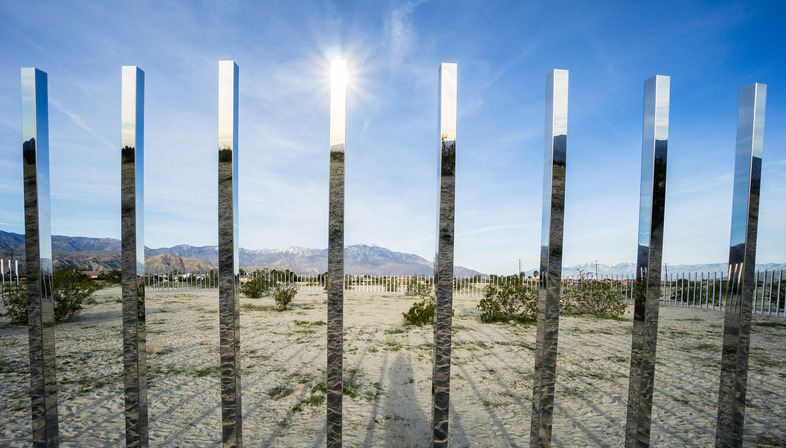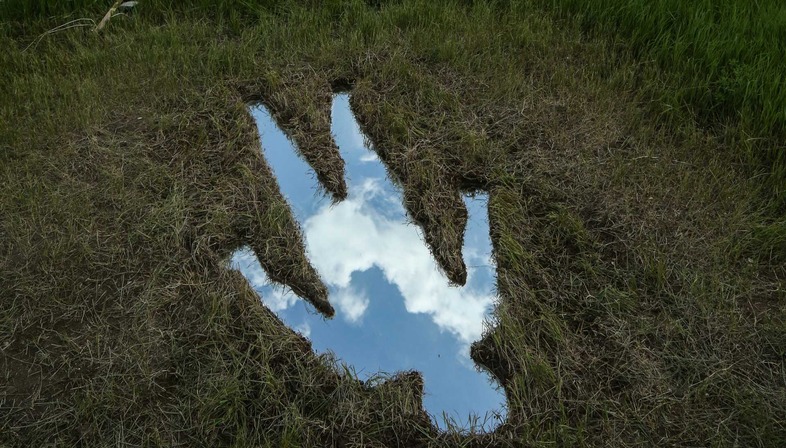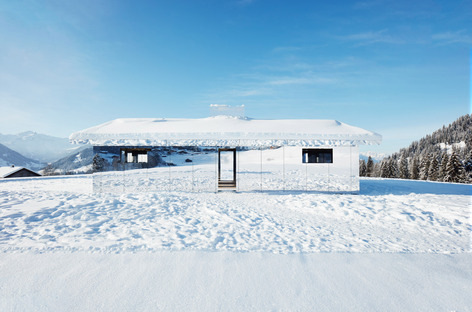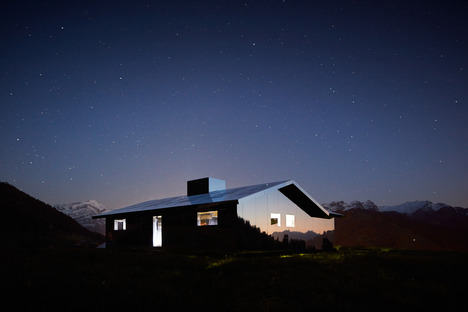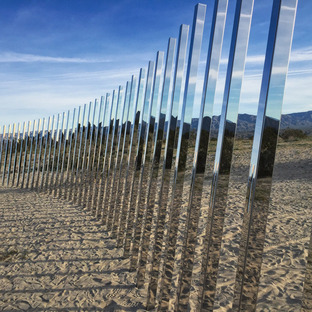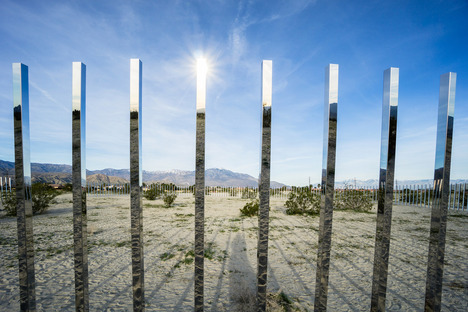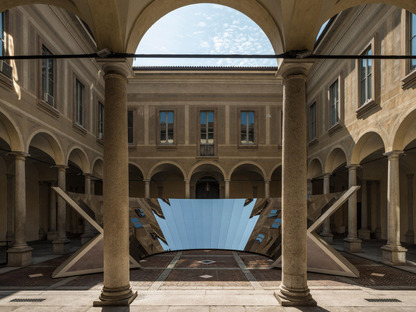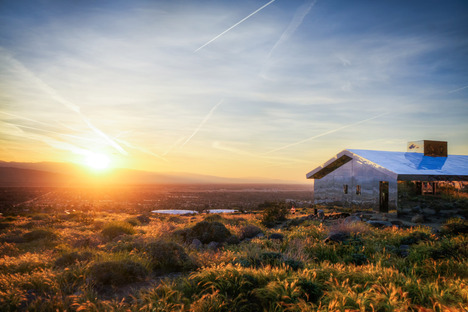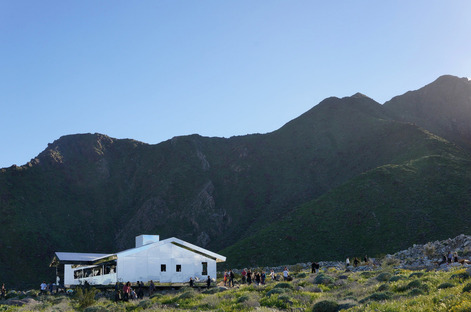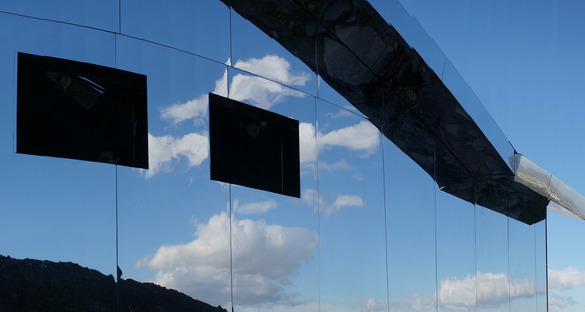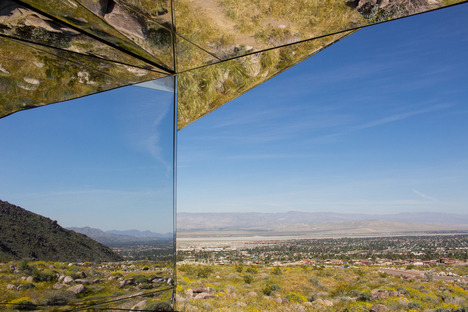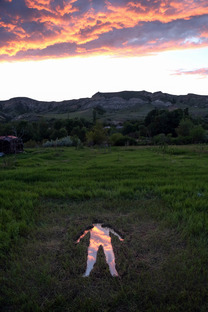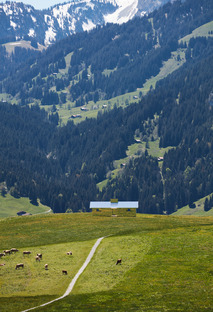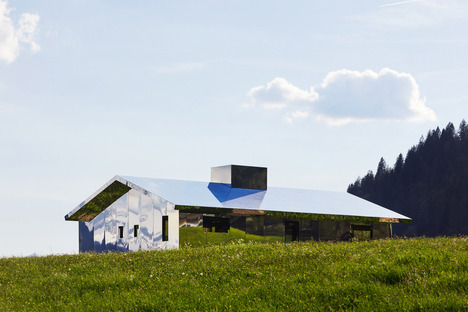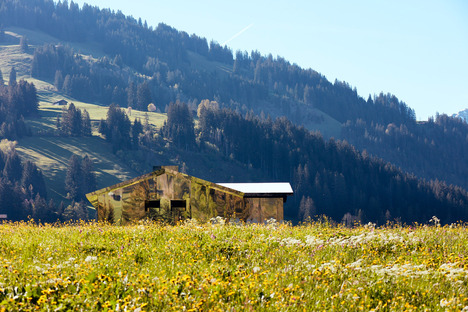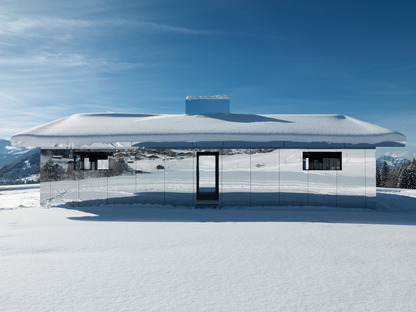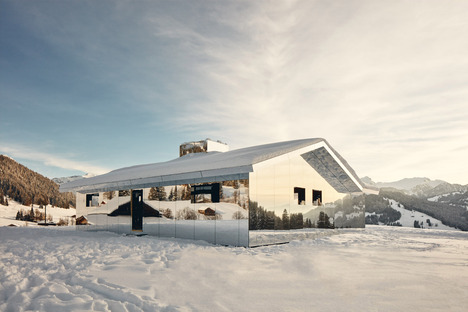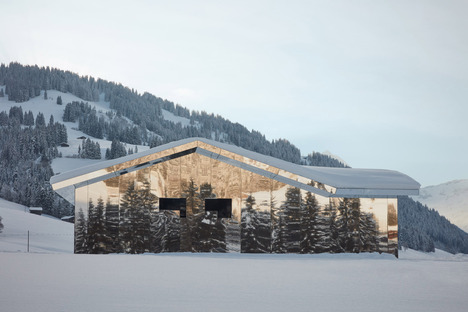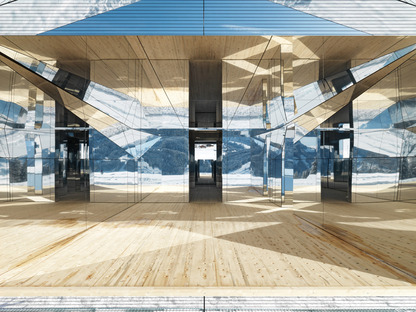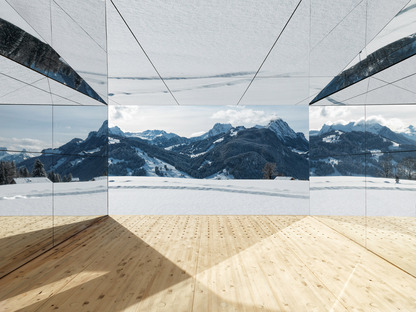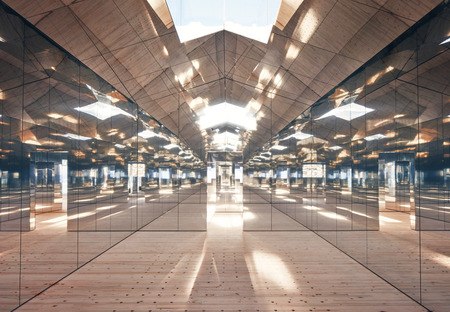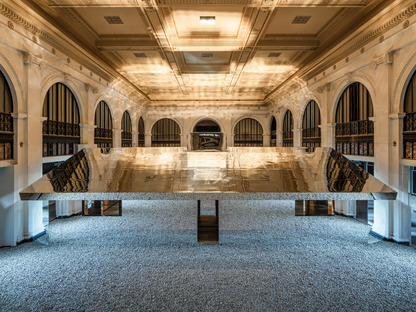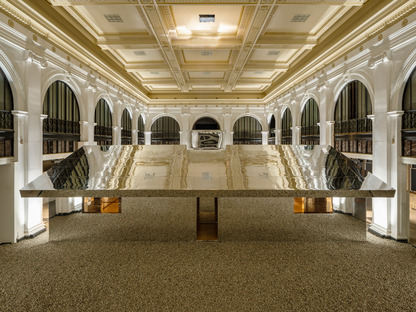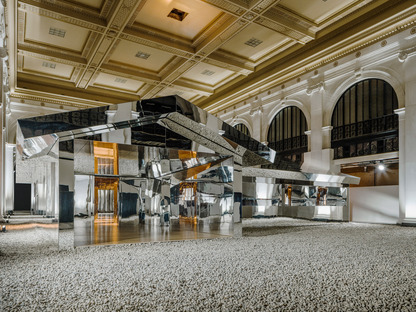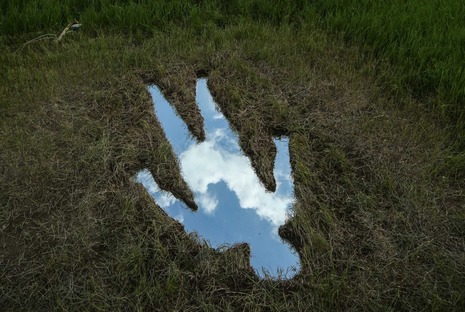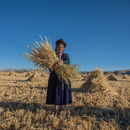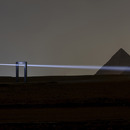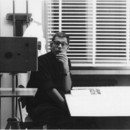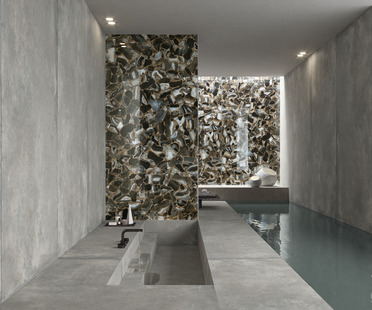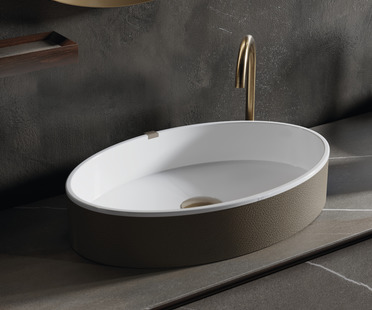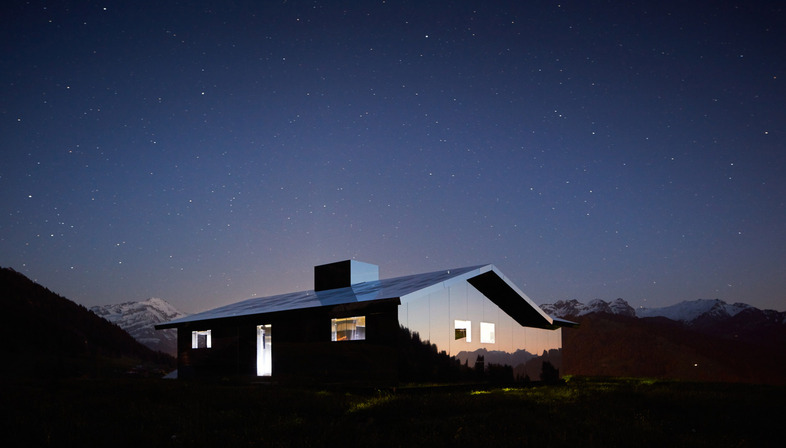
Paused...
In Lewis Carroll’s 'Through the Looking-Glass', Alice exclaims these precise words the instant she is about to embark on her once-in-a-lifetime experience: “Oh, Kitty! how nice it would be if we could only get through into Looking-glass House! I'm sure it's got, oh! such beautiful things in it! Let's pretend there's a way of getting through into it, somehow, Kitty. Let's pretend the glass has got all soft like gauze, so that we can get through. Why, it's turning into a sort of mist now, I declare! It'll be easy enough to get through”.
It is not exactly a sort of mist we have to cross, but rather the language of an allusive geometry, outlined by 300 polished stainless steel poles, arranged in a regular sequence, all angled at 10 degree, that in Palm Desert capture with magnetic force into a space which promises us to connect with ancestral energies. In the vastness of the desolate context, where the absence of everything amplifies with contrasts of incredible lyricism the beauty and power of natural primordial and atmospheric phenomena, is emphasized this line that, emanating the seduction of a mirage, indicates the magic circle it encloses. It imposes itself and then gradually fades into the sand and the shades of the sky, guiding toward a converging point, anticipating an esoteric experience, moments of contemplation and contact with the sublimity.
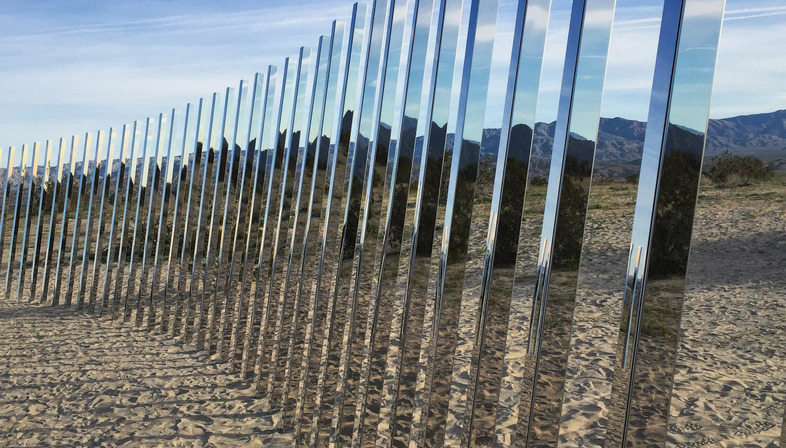
'The Circle of Land and Sky ‘, by Phillip K. Smith III conceived for the first edition of Desert X in 2017. Photo by Ken Larmon/Flickr.
Phillip K. Smith III, an American artist-architect, is the creator of this extensive atmospheric installation, entitled 'The Circle of Land and Sky ‘, conceived for the first edition of Desert X in 2017. Deeply rooted in this landscape, where he grew up and established his own studio, he realizes works mainly on a large scale, imbedded in natural environments as the desert or ocean beaches, whose soul-stirring enchantment and suggestiveness he loves to amplify and magnify. Sometimes, even if less frequently, he tackles the urban environment, as he did in 2018 during Milan’s Fuorisalone, in the courtyard of Palazzo Isimbardi, in Corso Monforte, exploring with 'Open Sky', a convex faceted composition of enormous polished stainless steel plates, an amalgam between sky and architecture. His intervention, achieving this symbiosis, confers the historic location particular vibes, suitable for escaping the city’s traffic and devoting some time to reflection.
Smith, rightly defined “a lightworker, an alchemist, an inventor and a magician", is perfectly aware that to aspire to "powerful and memorable experiences that we are unable to fully explain” is part of our human nature, convinced that "we desire mystery and beauty as they remind us of unity, love, immensity and incomprehensible complexity existing in the world ".
'The Circle of Land and Sky ‘,by Phillip K. Smith III conceived for the first edition of Desert X in 2017. Photo by Ken Larmon/Flickr.
Inspired by the mystery that the desert with its indescribable awe-striking beauty evokes, 'The Circle of Land and Sky’ with its sculptural ring, real but, at the same time, immaterial, made impalpable by the light reflections that continually renew on its components the eternity of cosmic cycles, invites us to experience a journey, which resembles a mystical, inscrutable ritual. The circle embodies the emblematic value of an archetype, alluding to the focal point of departure for an immersive, spiritual journey. It will be a timelessness, memorable communal and personal experience, which 'grabbing' people emotionally, will force them "to slow down and really look and experience the thing that’s in front of them, which quite often we don't have the opportunity to do in our everyday lives”.
I would like to express this project with the words of a famous writer, Susanna Tamaro. ‘Follow your heart’ could be the exhortation leading to that special place where "fallen stars disintegrate, becoming a kind of dust. The dust spread all around, but it is not ordinary dust, from dirty things. The dust of the stars is magical, it shimmers and vibrates without ever stopping and always forms the same shape, the shape of the circle ”. It is the description of the 'magic circle' that Tamaro in one of her children's books dedicates to the young readers, and I think exemplifies the situation very poetically, underlining the importance of maintaining a pure gaze and the capability to feel emotions.
The mirror often offers its complicity to artists provoking us, sometimes almost mimetically assimilating the surrounding and using a strong aesthetic attractiveness to push us to a pure ecstatic admiration, at times, exploiting the visual perception of beauty, making us reflect about what we are losing, incumbent disasters and the urgency to take our own responsibilities.
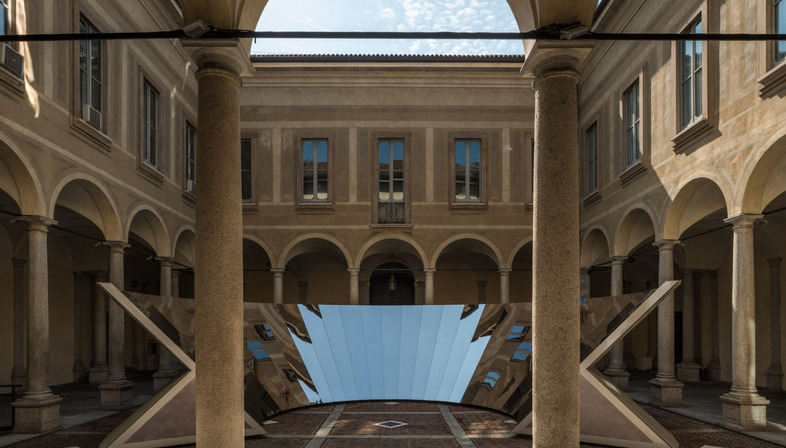
'Open Sky' for COS by Phillip K. Smith II, at Milan’s Fuorisalone, in the courtyard of Palazzo Isimbardi, 2018. Photo courtesy COS /Salone archive.
Soil impoverishment, fragility of an ecosystem and alteration of the biosphere are some of the issues that shake our consciences and polarize our attention. The Australian photographer Murray Fredericks attributes the cause of all these dysfunctions to an exasperated individualism, an obsessive egocentrism that legalises every act of supremacy and control by man over nature, in an era that has rightly been denominated Anthropocene. Focusing on this vanity that has erased all ethical environmental concerns, he realizes the absolutely sublime shots of the 'Vanity' series. The mirror, as symbol of narcissism, "emblematic of our obsession with ourselves, individually, and collectively”, is placed in the middle of endless striking scenarios, where light, color and space play undisturbed the leading role, diverting our attention from that pathological consideration of our egoistic 'I'.
Fredericks always portrays in solitude remote places, which present themselves as real spiritual itineraries, that he conquers with a fatigue of days and days of walking in the harshest climatic conditions, personally transporting all his equipment. He develops a relationship that makes physicality an inner conquest. This project arises from the juxtaposition of two mirrors that, facing each other and excluding his presence like that of any human, contribute to an effect of infinite reflection of the idyllic, absolutely desolate landscape, disorienting our spatial parameters and making us feel lost and insignificant in front of inscrutable, uninterrupted horizons. Mirrors act as an opening towards a depth and purity transcending the contingent, pushing the viewers to live moments of fusion with perfection, in a sort of redemption.
'Human (Nature)', by ICY & SOT, Tbilisi, Georgia. 2017. Photo courtesy of ICY & SOT.
ICY & SOT, known as the two brothers of street art, originally from the city of Tabriz, Iran, produce works mainly fueled by political dissent and social protest, due to their country's intolerant censorship. Above expressing themselves with activism towards those injustices that would not distinguish a civil society, they have, more recently, directed their commitment towards raising awareness, support and protection for our compromised ecosystem. 'Human (Nature)' inaugurates in 2017 a series of installations that, by condemning consumption and waste, two of the most ruinous plagues that are irreparably damaging our planet, hope to provoke a reaction, a change about irresponsible and devastating behaviors.
A mirrored surface, with human shape, lying in a vast plane in Tbilisi, Georgia, reflects the sky above, highlighting the modest size of man compared to the extensive green expanse. 'Nature's Reflection' leaves us free to interpret its enigmatic presence, even if probably it intends to metaphorically suggest the grave that man is digging with his own hands in the abused soil of earth that will surely outlive him. The mirrored intense blue sky could also allude to another urgent calamity, the disappearance of a precious, vital resource, the water swallowed with man in his burial pit.
An American artist and filmmaker, using the mirrors’ specular properties, has created several site-specific installations, focusing the attention, through the essential link that would exist between context and architecture, on the will to deepen dueling desires, innate in man, to preserve and conquer nature. One of these creations was conceived for the first edition, held in 2017, of Desert X, an art festival organized with the participation of international artists, not far from Palm Springs, in the valley between Whitewater Preserve and Coachella, southern California, with the intent to amplify and enhance the charm of an arid, barren landscape like that of the desert and to establish a cross-cultural dialogue on issues of vast global relevance, outside the museums and galleries’ claustrophobic walls.
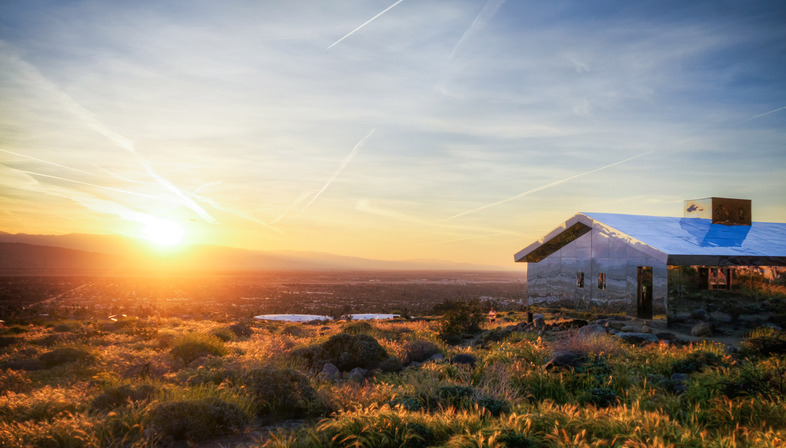
'Mirage', by Doug Aitken, conceived for Desert X, 2017. Photo courtesy of Ken Larmon/Flickr.
Doug Aitken, well known for exploring kinetic interactive syntheses using an array of media, presented, in the middle of nowhere, ‘Mirage’, a house sculpture modeled in a ranch style, completely mirror cladded, functioning "as a polychromatic prism of desert colors in the vast natural landscape”. Expressing itself with a language that sounds as a contamination between architecture and Land Art, ‘Mirage’ " distills the recognizable and repetitious suburban home into the essence of its lines, reflecting and disappearing into the vast western landscape". The building blurs the banal, anonymous, repetitiveness of certain post-war American suburbs with new accents of surprising originality. In 2019 Aitken, with a tone of criticism, decided to "embrace the banal as opposed to looking at the regional as exotic", installing an identical type of house, the ‘Mirage Gstaad’, in the alpine resort of Gstaad, in the Swiss canton of Bern, on the occasion of another festival, Elevation 1049. Once more the natural light and changing weather conditions gave life to the work, which, become "the sum of its surrounding landscape”, shows "in an almost chameleon-like form" an authentic respect for the natural environment.
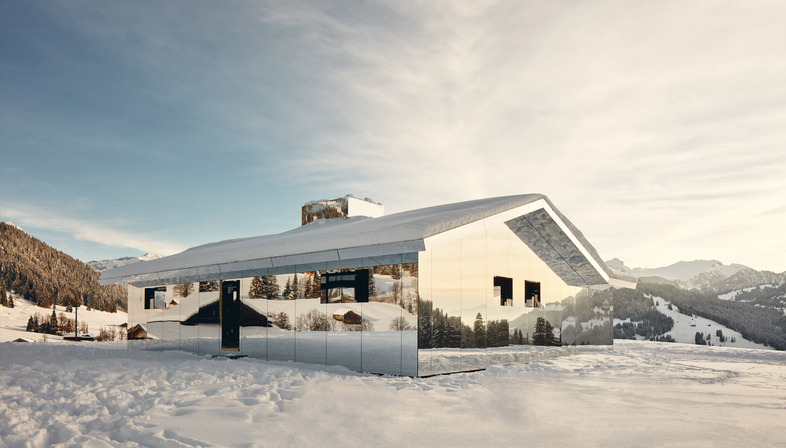
'Mirage Gstaad', by Doug Aitken, for Elevation 1049: Frequencies,Switzerland in 2019. Photo by Torvioll Jashari, courtesy of artist & Luma Foundation.
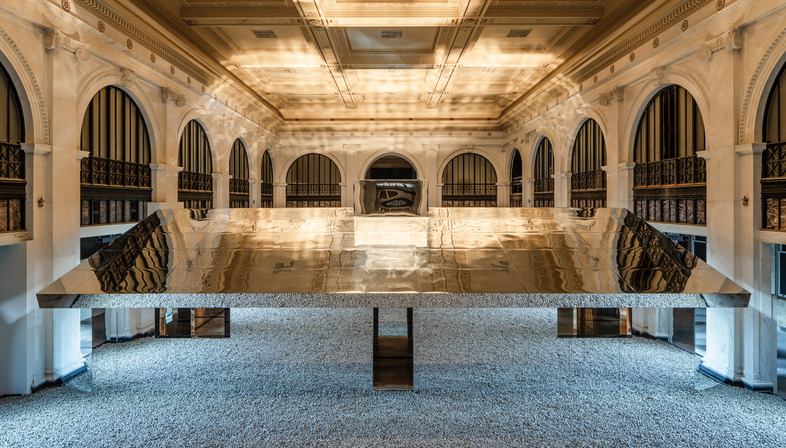
'Mirage Detroit', by Doug Aitken, Detroit, 2018. Photo by Lance Gerber, courtesy the artist and Library Street Collective.
These various minimal structures, geometric shaped-house sculptures, anonymous houses whose architecture you don't remember, despite their apparent uniformity, acquire each one, deprived of any evident banality, a precise, distinct identity. Light becomes an ingredient of fundamental importance that helps to weave the textures. Each visitor will have a unique experience and will read a different narrative. Their skins have learned to tell a story that speaks of interaction with a beloved and respected landscape, which does not want to be destroyed for yet another building without soul or personality.
Virginia Cucchi
Credits:
Doug Aitken: https://www.dougaitkenworkshop.com/
Phillip K. Smith III: https://www.pks3.com/
Murray Fredericks: https://murrayfredericks.com/
ICY & SOT: https://icyandsot.com/
Luma Foundation: https://www.luma-arles.org/luma/home.html
Library Street Collective: https://www.lscgallery.com/
Desert X: https://desertx.org/
Cover: Doug Aitken, Mirage Gstaad, 2019. Part of Elevation 1049: Frequencies, Gstaad, Switzerland. Image courtesy of the Artist and Luma Foundation; Photo Torvioll Jashari.
01: Doug Aitken, Mirage Gstaad, 2019. Part of Elevation 1049: Frequencies, Gstaad, Switzerland. Image courtesy of the Artist and Luma Foundation; Photo Torvioll Jashari.
02-03: Philip K. Smith III, The Circle of Land and Sky. Part of the first edition of Desert X in 2017. Photo by Ken Larmon/Flickr
04: Philip K. Smith III, Open Sky at Milan’s Fuorisalone, in the courtyard of Palazzo Isimbardi, 2018. Photo courtesy/archive COS.
05: Doug Aitken, Mirage, 2017. Part of the first edition of Desert X in 2017. Photo by Ken Larmon/Flickr
06-07: Doug Aitken, Mirage, 2017. Part of the first edition of Desert X in 2017. Photo by Darek/Flickr
08: Doug Aitken, Mirage, 2017. Part of the first edition of Desert X in 2017. Photo by Binx/Flickr
09-10: ICY&SOT, Human (Nature)' ,Tbilisi, Georgia. 2017.
11-13, 15-16, 19 : Doug Aitken, Mirage Gstaad, 2019. Part of Elevation 1049: Frequencies, Gstaad, Switzerland. Image courtesy of the Artist and Luma Foundation; Photo Torvioll Jashari.
14, 17-18 : Doug Aitken, Mirage Gstaad, 2019. Part of Elevation 1049: Frequencies, Gstaad, Switzerland. Image courtesy of the Artist and Luma Foundation; Photo Stefan Altenburger.
20-23 : Doug Aitken, Mirage Detroit, 2018. Photo by Lance Gerber. Image courtesy of the Artist and Library Street Collective










